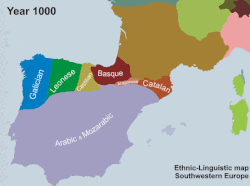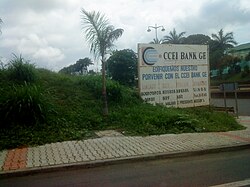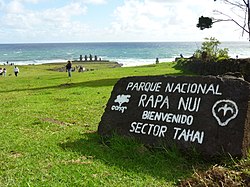Spanish language
Spanish (Spanish: español, pronounced "Eh-span-yole", IPA: /espaɲol/), also called Castilian, is a Romance language. It is the most spoken Romance language in the world. As of December 2021, over 489 million people in the world spoke Spanish as their first language.[1]
| Spanish | ||||
|---|---|---|---|---|
| Castilian | ||||
| Pronunciation | [espaˈɲol], [kasteˈʎano] | |||
| Native to | ||||
| Region | Spain, Latin America and the United States of America (see below) | |||
| Ethnicity | Spaniards | |||
| Native speakers | [1] +99 million as a second language[1] 595 million total | |||
| Language family | ||||
| Early forms: | Old Spanish
| |||
| Writing system | Latin (Spanish alphabet) Spanish Braille | |||
| Official status | ||||
| Official language in |
International organisations:
| |||
| Regulated by | Association of Spanish Language Academies (Real Academia Española and 21 other national Spanish language academies) | |||
| Language codes | ||||
| ISO 639-1 | es | |||
| ISO 639-2 | spa | |||
| ISO 639-3 | spa | |||
| Linguasphere | 51-AAA-b | |||
 Countries where Spanish is the official language
Countries where Spanish is a co-official language Countries where Spanish is culturally important or is spoken by more than 20% of the population Countries where Spanish is spoken by less than 20% of the population | ||||
| ||||
Brief history
The Spanish language came from a dialect of spoken Latin. In 218 B.C., it was brought to the Iberian Peninsula by the Romans. After evolving and improving for centuries, it is the world’s 4th most spoken language today with over 489 million native speakers, after English, Mandarin Chinese, and Hindi.
Usage
Spanish is used by many people in the world today, partly because Spain traveled and colonized many different parts of the world and created many new countries and governments. The countries with Spanish as an official language are called the Hispanic countries. Most of them are in the Americas, which make up Latin America. They include the following:
In North America, Central America, and the Caribbean Islands:
- Costa Rica
- Cuba
- The Dominican Republic
- Guatemala
- Honduras
- Mexico
- Nicaragua
- Panama
- Puerto Rico (territory of the United States)
- El Salvador
- United States
In the United States of America[2] and Belize,[3] most people use English, but Spanish is the second-most common language.
In South America:
Many Brazilians learn Spanish as a second language even though Brazil's official language is Portuguese.[4]
In other parts of the world:
Related languages
The Spanish language was originally the language of Castile.[7] When the Western Roman Empire collapsed, Latin changed in different ways in different provinces.[8] The Latin spoken in the Iberian Peninsula developed into the Ibero-Romance language in the 6th century.[9] Castilian and Portuguese became separate languages around the 12th century.[9]
In Spain, there are other languages that also came from Latin that are connected to Spanish, like Catalan, and Galician.[10] Basque, also called Euskera or Euskara, is spoken in the Basque region of northern Spain and the southern region of France. Very different from Spanish,[11] Basque is a language isolate since it is not known to have descended from any language family.
Catalan is not a dialect of Spanish and is actually more closely related to French.[7]
Name
Spanish is sometimes called Castellano[12] because Castile is the region in Spain that is the origin of the language.[8]
The Spanish word for Spanish is "español", and the Spanish word for Castilian is "castellano".[7] In the other Romance languages spoken on the Iberian Peninsula, such as Galician, Catalan, Asturian, and others, Spanish is usually called "Castellán" or "Castellà" instead of "Spanish".[13][better source needed] In Spain, the name of the subject in schools is "lengua castellana" (Castilian language). However, in the regions of Spain in which people speak only Spanish, people call their language Spanish.[13][better source needed]
In Portuguese, the word "castelhano" is common to mention Spanish,[14] however, in informal language, the most preferred name for the language is "espanhol". Portuguese, which is spoken in Portugal and Brazil, has many similarities to Spanish.[15]
Statistics
In 2009, for the first time in history, Spanish was the most common "mother tongue" language of the western world, more than English. It was also the second most common language on Earth, after Chinese. As of 2016, the three most common languages in the world are:[1]
- Chinese: Spoken by about 1.305 billion people
- Spanish: Spoken by about 427 million people in 34 different countries
- English: Spoken by 339 million people in 108 different countries
Spanish Language Media
The Cartularies of Valpuesta, written in a late form of Latin, were declared in 2010 by the Royal Spanish Academy as the record of the earliest words written in Castilian, predating those of the Glosas Emilianenses.
Spanish language signage in Malabo, capital city of Equatorial Guinea
An 1892 issue of La Solidaridad, a Spanish-language newspaper on the colonial Philippines published in Barcelona by Filipino exiles and international students
Map of the Chavacano language in various provinces of the Philippines, as well as Sabah in Malaysia (where it is spoken by immigrants)
Announcement in Spanish on Easter Island, welcoming visitors to Rapa Nui National Park
Related pages
- Hispanidad, people and nations that share the Spanish language and culture
References
- ↑ 1.0 1.1 1.2 1.3 Fernández Vítores, David (2021): El español: una lengua viva – Informe 2021 (PDF) (Report). Instituto Cervantes. 2020. Archived (PDF) from the original on 18 February 2020. Retrieved 14 December 2020.
- ↑ Ryan, Camille (August 2013). Language Use in the United States: 2011 – American Community Survey Reports (PDF) (Report). United States Census Bureau.
- ↑ "Belize". The World Factbook. United States Central Intelligence Agency. November 10, 2016. Archived from the original on May 13, 2013. Retrieved November 30, 2016.
- ↑ "Brazil". The World Factbook. United States Central Intelligence Agency. November 10, 2016. Archived from the original on December 22, 2015. Retrieved November 30, 2016.
- ↑ "Spanish is once again a compulsory subject in the Philippines". Archived from the original on July 14, 2010. Retrieved November 30, 2016.
- ↑ "Brazil". The World Factbook. United States Central Intelligence Agency. November 10, 2016. Archived from the original on August 31, 2020. Retrieved November 30, 2016.
- ↑ 7.0 7.1 7.2 "What Spanish is spoken in Barcelona – Catalan vs. Castilian?". Barcelona University.
- ↑ 8.0 8.1 "What kind of Spanish is spoken in Madrid – is Castilian the purest type of Spanish?". Madrid University.
- ↑ 9.0 9.1 "Ibero-Romance Languages". Project Gutenberg Self-Publishing Press. World Heritage Encyclopedia.
- ↑ "Languages across Europe: Spain". BBC. October 14, 2014.
- ↑ Michelena, Luis, and de Rijk, Rudolf P.G. (February 19, 2009). "Basque Language". Encyclopaedia Britannica. Encyclopaedia Britannica, Inc.
{{cite web}}: CS1 maint: multiple names: authors list (link) - ↑ "Language Throne- The Best Resources To Speak Any Language Fluently". Language Throne. Retrieved 2021-09-01.
- ↑ 13.0 13.1 en:Names given to the Spanish language
- ↑ Aseguinolaza, Fernando Cabo; Abuin, Anxo; Dominguez, Cesar (eds.). A Comparative History of Literatures in the Iberian Peninsula, Volume 1. John Benjamins Publishing Company. ISBN 978-90-272-3457-5.
- ↑ Sala, Marius; Posner, Rebecca (November 30, 2015). "Portuguese Language". Encyclopaedia Britannica. Encyclopedia Britannica Inc.
Other websites
| This language has its own Wikipedia project. See the Spanish language edition. |
- Ethnologue report for Spanish
- Spanish phrasebook on Wikivoyage
- The Project Gutenberg EBook of A First Spanish Reader by Erwin W. Roessler and Alfred Remy.
- Spanish to English Archived 2017-08-08 at the Wayback Machine online translation








